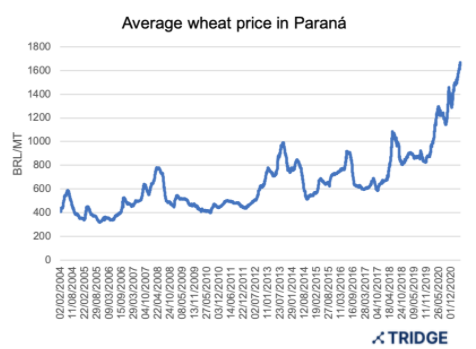Brazil will start to invest in wheat production
Brazil is currently a net importer of wheat, producing 6 million MT and importing 7.2 million MT in 2020, during which time the prices kept firm for several reasons. The pandemic started with already inflated wheat prices due to low carryover stock from 2019 that had a low producing year. During the pandemic, the hoarding behavior of consumers increased the demand for wheat-based products and pushed raw materials prices. The recurring lockdowns that happened throughout 2020 have disrupted logistics and crushing operations, reducing the availability of wheat flour. High grain prices such as soybeans and corn helped sustain the wheat prices as well. The increase in costs of production as imported inputs were affected by the weak BRL.
The high prices continued in 2021. The average price of wheat in Paraná, the main producing state, in April 2021 was BRL 1605 per MT (about USD 307), a 36.7% increase compared to the average pricing of the same period from 2020. During the last 10 years, Brazilian farmers had been facing low prices that made the crop a minor winter crop. However, this upward price trend in the last two years has prompted the interest of farmers in investing in this crop again. The Brazilian Agricultural Research Corporation (Embrapa) and the wheat farmers’ union have joined forces to increase domestic wheat production. The main goal of this union is to argue reducing wheat imports and boost domestic supply for demand by investing further in the wheat research sector.

Planted areas, in the Central and South regions of Brazil together are forecasted to increase from 2,350 thousand ha to 2,650 thousand ha representing a 12.8% growth in the next two years. This growth will enable Brazil to reduce the imports of wheat by about BRL 1.35 billion (about USD 257.6 million).
The wheat sowing for MY 2021 has started in April and is progressing at a good speed. The weekly report from the Agricultural Department of Economy (Deral) shows sowing progress of 9% in Paraná state, of which 97% are at the germination stage already. The forecasted weather for the planting regions is favorable for plant growth, and dry air is expected during the harvesting period. The dry air will allow the wheat crop to have a high quality, and farmers are expecting good results. Therefore, the overall production volume is expected to reach 7.26 million MT, an increase of 16.9% compared to the previous season.
As the pandemic second wave continues, The demand for wheat-based products is expected to remain high, as dry pasta, cookies, and wheat flour are items subject to stocking and an important source of carbohydrates in the Brazilian household.
The domestic wheat prices are expected to continue firm during 2021, as high demand continues and imported wheat from Argentina and the US range above USD 100 per 60 kg bags, pushing up the domestic wheat quotes.
Sources:
- Canal Rural. Translated from Portuguese. “Wheat farmers profit is the largest in 20 years”
- Cepea. Translated from Portuguese. “Wheat prices”.
- Embrapa. Translated from Portuguese. “Wheat”.
- Isto é. Translated from Portuguese. “Wheat planted area reach 9%”.
- Sinditrigo. Translated from Portuguese. “Wheat Annual balance 2020”